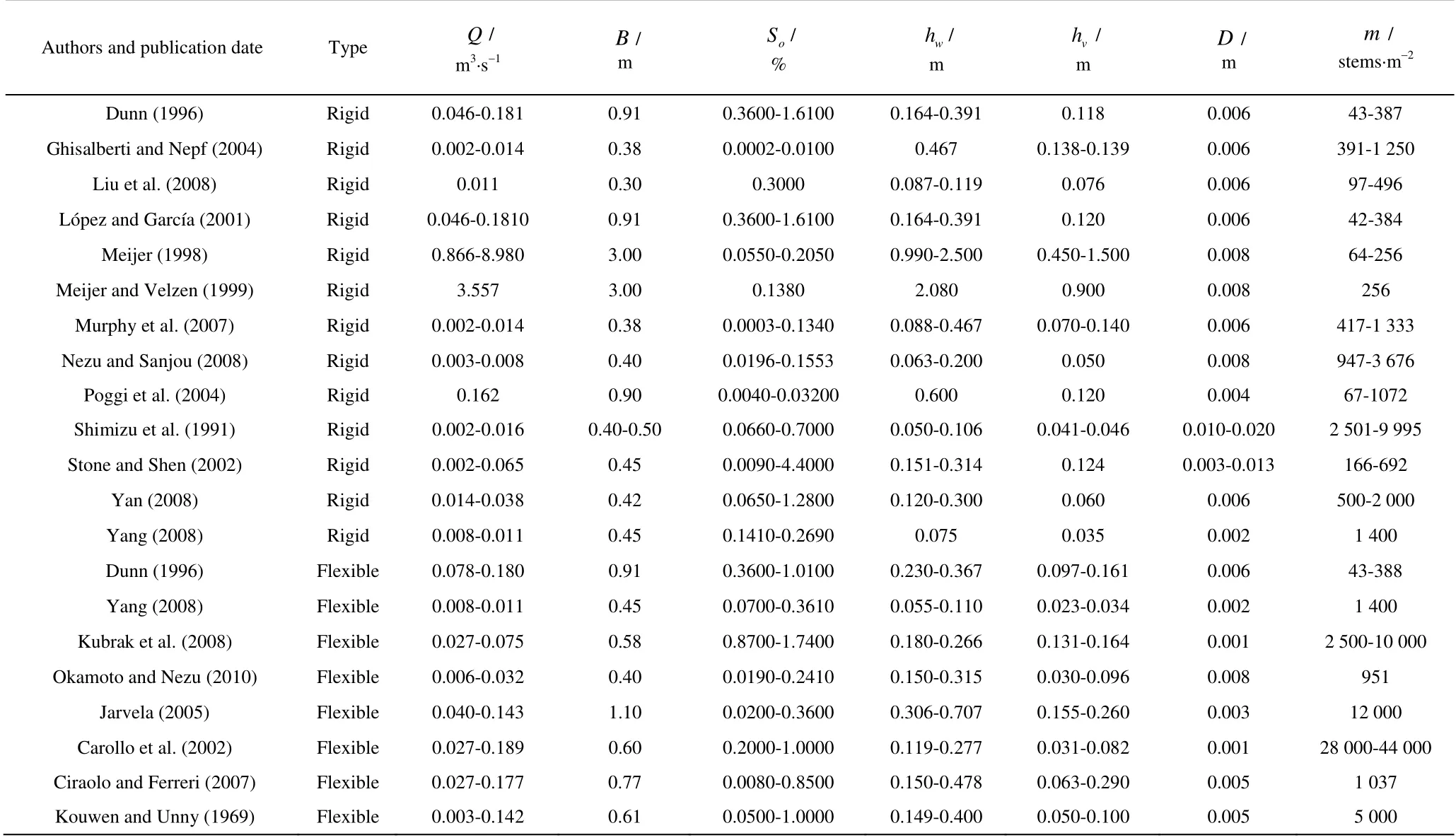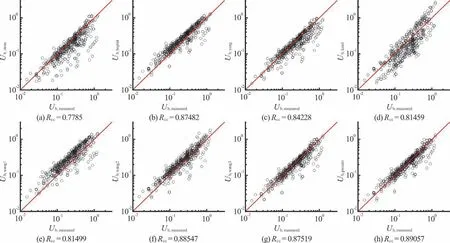Predictions of bulk velocity for open channel flow through submerged vegetation*
Wei-jie Wang,Xiao-yu Cui,Fei Dong,Wen-qi Peng,Zhen Han,Ai-ping Huang,Xue-kai Chen,Yuan Si
1.State Key Laboratory of Simulation and Regulation of Water Cycle in River Basin,China Institute of Water Resourcesand Hydropower Research,Beijing 100038,China
2.Department of Water Ecology and Environment,China Institute of Water Resourcesand Hydropower Research,Beijing 100038,China
Abstract:Vegetation is of great significance in river ecosystems in terms of hydrodynamics,water environment and ecology.The question of how to predict the bulk velocity in channel flow through submerged vegetation is currently a hot topic in hydraulics research.The present study addresses this question.The various formulae used for bulk velocity estimation in previous work were reviewed and compared.The main novelty of this paper is that a new expression of friction factor is proposed as a function of two dimensionless factors,and the number of tuning parameters is less than that in previous work.A comparison of measured and calculated data was conducted for flow through submerged rigid and flexible vegetation.The comparison showed that the proposed new model can make more accurate predictions than previous models.It is envisaged that the proposed formulation can be usefully employed in eco-hydraulicspredictions.
Key words:Vegetation, resistance,drag coefficient,bulk velocity,open channel flow
Investigating the flow characteristics of vegetated channels is an important research direction in environmental hydraulics[1-7].The flow region can be divided into a single layer,two layers,three layers,or four layers along the vertical direction according to different flow turbulence characteristics,which include the viscous bottom zone,wake correction zone,mixing layer,and boundary layer zone[8-13].
In practical applications,most attention is paid to the bulk velocity of flow through vegetation,i.e.,the depth-averaged velocity for the whole flow depth.In the present paper,predictions from different research groups are illustrated and compared,and,from the analysis,a new empirical expression is proposed.
Stone and Shen[14]conducted laboratory experiments using circular cylindrical roughness to investigate the hydraulics of vegetated flow,and showed that the depth-averaged velocity for the whole flow depth was coefficient for smooth beds.

Yang and Choi[13]assumed a uniform distribution of flow velocity in the vegetation layer, and adopted a logarithmic distribution of flow velocity in the free water layer. By establishing a two-layer model of flow velocity distribution with setting thresholds for sparse vegetation and dense vegetation, the following formula for predicting bulk velocity was obtained:

where parameters



where the depth-averaged velocity for the vegetation layer is

and the depth-averaged velocity for the surface layer is

and the momentum absorption coefficient is

and the roughness length scale for vegetation is

Wang et al.[17]proposed a new roughness height for submerged vegetation in open channel flow

where Lsis the spatial averaged distance of adjacent stems. Based on the Darcy-Weisbach formula, the friction factor can be expressed as

where the depth-averaged velocity for the vegetation layer is calculated by

and the power law was adopted for the vegetationrelated friction factor

where Rvis the vegetation-related hydraulic radius

and the following values were obtained empirically:λ1=0.8872, λ2=0.6536. Then, the bulk velocity can be estimated by


Equations(16),(19)reveal that the friction factor of flow through submerged vegetation can be expressed as a function of αand η ,with several tuning parameters.
To obtain a simpler and more efficient formula for the friction factor,a new frame is proposed that only hasone tuning parameter,0p

and the bulk velocity can be expressed as

where0p is the parameter to be determined.
The drag coefficient of vegetationdC ,can be calculated using[18]

To provide a comparison with previous work[17],more experimental data were collected and shown inTable 1,including data for rigid and flexible vegetation (see the supplementary information in Wang et al.[18]for details).In Table 1,Q is the flow rate,B is the channel width andoS is the bed slope.

Table 1 Summary of experimental data

Fig.1 (Color online)Bulk velocity:A comparisonsof measured data and model calculations
Regression analysis showed that p0=7.86is the best-fitting parameter.A comparison between measured bulk velocities and different calculations is provided in Fig.1.Results show that the newly proposed expression is more accurate than other formulae in terms of the correlation coefficientccR .The correlation coefficientccR was 0.89 for the present model,which was the highest for the models investigated in thispaper.
The following conclusions can be drawn:different formulae for bulk velocity estimation of flow through submerged vegetation were reviewed and compared.From an analysis of the relationship between friction and two dimensionless factors,new formulae for predicting the friction factor and bulk velocity were proposed.A comparison of measured and calculated data was carried out for flow through submerged rigid and flexible vegetation.The results show that the proposed new model can provide more accurate predictions,and with less parameters,than previousmodels.
AcknowledgementsThis work was supported by the National Water Pollution Control and Treatment Science and Technology Major Project of China (Grant No.2018ZX07105-002), the IWHR Research and Development Support Program (Grant Nos. WE0145B062019,WE0145B422019 and WE0145B382019)and the National Key Research and Development Project (Grant No.2018YFC0407702).
- 水动力学研究与进展 B辑的其它文章
- Development and application of a new random walk model to simulate the transport of degradablepollutants*
- Some notes on numerical simulation of the turbulent cavitating flow with a dynamic cubic nonlinear sub-grid scalemodel in OpenFOAM*
- On solitary wave in nonuniform shear currents *
- Fission law of solitary waves propagating over sharply variable topography *
- A TensorFlow-based new high-performance computational framework for CFD *
- Experimental investigation of wall-bounded turbulence drag reduction by active control of double piezoelectric vibrator *

